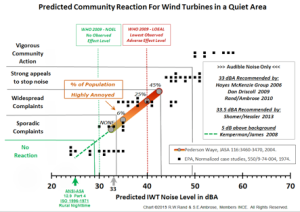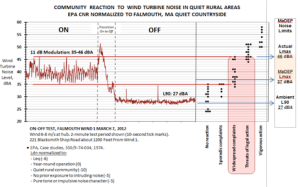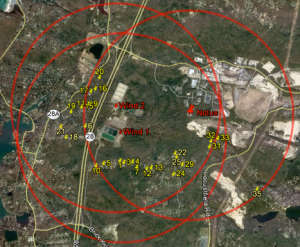Wind Turbine Noise Complaint Predictions Made Easy
by Steve Ambrose and Rob Rand
Introduction
The public response to wind turbines operating in a number of Massachusetts coastal communities have been greeted with a mixed response. A series of one-page articles have been written based on the acoustic investigations and research by Robert Rand and Stephen Ambrose. They are career-long friends and colleagues dating back to 1981 when they both worked as noise control engineers for Stone & Webster Engineering Corporation in Boston, Massachusetts. Currently, they are independent acousticians working in Maine.
There should be no wind turbine complaints about noise with today’s knowledge and instrument capabilities. They have never investigated a noise problem where the public has been so vocal about ruined lives and home abandonment. Why are neighbors complaining about wind turbines? Why are regulatory officials unable to protect public health and well-being. The following is written to help answer these two-questions. (Click to view a PDF version of the four one-page articles).
Wind Turbine Noise Complaint Predictions Made Easy – Part 1
Acousticians have known for decades how to predict the community reaction to a new noise source. Wind turbine consultants have chosen not to predict the community reaction as they have previously done for other community noise sources. If they had, there would be far fewer wind turbine sites with neighbors complaining loudly about excessive noise and adverse health impacts.
In 1974, the USEPA published a methodology that can predict the community reaction to a new noise. A simple chart can be used that shows the community reactions (y-axis) versus noise level (x-axis). This chart was developed from 55 community noise case studies (black squares). The baseline noise levels include adjustments for the existing ambient, prior noise experience, and sound character. The predicted wind turbine noise level is plotted on the ‘x-axis’ and the predicted community reaction is determined by the highest reaction, indicated by the black squares. Here are some examples: 32 dBA no reaction and sporadic complaints, 37 dBA widespread complaints, 45 dBA strong appeals to stop noise and 54 dBA vigorous community action, the highest.
The International Standards Organization (ISO) determined that 25 dBA represents a rural nighttime environment. The World Health Organization (WHO) found that noise below 30 dBA had no observed effect level (NOEL) and 40 dBA represented the lowest observed adverse effect level (NOAEL) for noise sources that excluded wind turbines. Wind turbines produce strong low frequency energy that may reduce the WHO cautionary levels by 5 dB, thereby showing closer agreement with the 33 dBA recommendations.
Pederson & Waye (2004) research found that when wind turbine noise levels reached 35 dBA, 6% of the population was highly annoyed, and this rapidly increased to 25% at 40 dBA. Independent researchers recommend that noise levels should not exceed 33 dBA, which is near the upper limit for sporadic complaints, or a maximum increase of 5 dB, whichever is more stringent.
Wind Turbine Noise Complaint Predictions Made Easy – Part 2
People react in a predictable manner to changes in sound level and frequency content caused by a new noise source. Wind turbines are the cause for numerous complaints about excessive noise and adverse health effects. These complaints will continue to be a public health hazard as long as modern acoustic instruments are used without a person listening to identify the sound sources or by manipulating computer prediction models to provide acceptable results. Wind turbine predictions are based on meeting a specific noise level. Regulatory boards and agencies are not assessing noise levels consistent with how people hear.
The wind turbines at Falmouth Massachusetts clearly show why there are so many neighbors complaining. An effective way to evaluate a sound source is by comparing the ON operation to OFF. The graph shows wind turbine ON fluctuates from 35 to 46 dBA and when OFF decreases to 27 dBA.
Using the USEPA (1974) community noise assessment methodology adjusted for a quiet area, the predicted public reaction for wind turbine noise indicates widespread complaints and threats of legal action, as shown by the shaded box. Massachusetts DEP noise regulation limits the wind turbine ON maximum levels to no more than 10 dB above the ambient background (L90, exceeded 90% of the time) when OFF. The sound level increase is 19 dB for wind turbine operation.
Wind Turbine Noise Complaint Predictions Made Easy – Part 3
Sleep interruption and disturbance indicates the real potential for causing significant public harm from nearby wind turbines. A peer-reviewed research paper has investigated residents living near GE 1.5 MW wind turbines. Dr. Michael Nissenbaum, Jeffrey Aramini and Christopher Hanning published “Effects of industrial wind turbine noise on sleep and health” in the peer-reviewed bi-monthly journal Noise & Health, September-October 2012.
The study focused on sleep quality as defined by the Pittsburg Sleep Quality Index (PSQI), daytime sleepiness by Epworth Sleepiness Score (ESS), and general health according to SF36 ver2; Mental Component Score(MSC) and Physical Component Score (PSC). Residents received questionnaires based on participant-inclusion criteria for individuals living within 1.5-km (4921-ft) of the nearest 1.5 MW wind turbine(s). Baseline random samples were collected from residents living 3 to 7 km (9840 to 22,965-ft) away. The study conclusion has a strong recommendation for a separation distance of 1.4-km (4593-ft) away from a 1.5 MW wind turbine. This would be especially true for wind turbines located in quiet environments.
An aerial photo shows the locations of Falmouth’s Wind 1, 2 and NOTUS turbines as red pins. The above sleep study-recommended separation distance of nearly 4600 ft is shown as red circles. The Falmouth Board of Health’s health study (June 11, 2012) confirms the sleep study’s conclusion for complaints inside the red circles with yellow pins inside.
Wind Turbine Noise Complaint Predictions Made Easy – Part 4
Wind turbine developers promote wind energy for financial benefit for communities when they are built on municipally-owned properties as in Falmouth, Kingston, Scituate and Fairhaven. In return, towns relax their bylaw restrictions to permit loud industrial-type noise sources on municipal land often near quiet residential areas. Town planners approve wind turbine development without performing proper reviews as required in the bylaws. Towns understand they can build a municipal project in any land use zone. However, these projects still need to comply with the zoning bylaws.
Zoning bylaws are enacted to control community development to minimize conflicts between abutting land uses. Industrial and commercial development often produces more traffic, noise, smoke, odors, etc. than residential use. Industrial and commercial facilities are limited to districts with large lots and setback distances. Residential district restrictions protect neighbors’ expectations for peace, tranquility and protection of public health and wellbeing.
Bylaws are implemented to provide guidance to town officials and regulatory boards. Public officials are required to perform their duties in a consistent manner. Boards review new developments for appropriate economics, engineering and environmental impacts. Decisions can become emotional when there are disputed considerations for public good versus public harm. Boards are required to enforce their bylaws and should not alter rules, grant waivers or create amendments to benefit a project under consideration.
Too many towns have adopted changes to encourage wind turbine development, changes which were later proven detrimental to public health, safety and wellbeing. Large wind turbines produce loud noise levels that travel thousands of feet and could not comply with existing town bylaw noise limits.
Trackbacks
- Getting Away with Murder: How the Wind Industry Rigged Noise Rules Around the World – STOP THESE THINGS
- Wind Turbine Noise Adversely Impacts Nearby People and Animals – Dogging Vermont Issues
- People are Harmed by Wind Turbine Noise. | "Mothers Against Wind Turbines™" Phoenix Rising…
- Recent Energy And Environmental News – March 9th 2015 | PA Pundits - International
- Wind Turbine Noise–Complaints Easy to Understand | Wind Wise ~ Massachusetts
- Falmouth Human Rights Conference Highlights | Wind Wise ~ Massachusetts
- San Diego Loves Green – Wind Turbine Syndrome is not Hilarious
- Predictable–Noise Complaints from Wind Turbines « Wind Wise ~ Massachusetts



I live near an Enel Green Power ( A subsideary of an Italian company) farm and suffer continuously from noise changing from constant loud viderations and tumling like noise. The nearst turbine was errected less than a mile from my home in 2008. It was bult by Texas Wind Power and sold and resold to Enel. They boast its the tallest in the US. I have complained and at first the local manager sought to help but was quickly told to turn it over to a supervisor. After denying problems I sent photos of Wind turins with darken turbine fans insisting the noise was louder and louder. Ive left messages with the main us office and extentions were changed so that I could not leave further messages. They have passed me on to their legal personel and now I can only leave voicemail for her (Megan) who will not return calls. I am now ready to take the next step in dealing with this problem. the sounds change in rection to wind and temprature and direction as well as a buzzing sound when thier breaks are on. Someone would have to spernd days and nights inside my house to fully understand.
Excerpts from the article:
“In 1974, the USEPA published a methodology that can predict the community reaction to a new noise.”
The authors are referring to the EPA Office of noise Abatement and Control (ONAC) that conducted that research under the authority of the Noise Control Act of 1972. I’m glad they are making use of that research in analyzing Wind Turbine noise pollution. Unfortunately, Congress cut the funding of the ONAC in 1982 mostly ending the federal government’s research in noise pollution. Had the ONAC been allowed to continue it’s good work we might have had proper noise pollution regulations to effectively deal with Wind Turbines.
“Wind turbines are the cause for numerous complaints about excessive noise and adverse health effects. These complaints will continue to be a public health hazard as long as modern acoustic instruments are used without a person listening to identify the sound sources or by manipulating computer prediction models to provide acceptable results. Wind turbine predictions are based on meeting a specific noise level. Regulatory boards and agencies are not assessing noise levels consistent with how people hear.”
“Sleep interruption and disturbance indicates the real potential for causing significant public harm from nearby wind turbines.”
Yes, noise pollution has long been recognized by thoughtful entities as a public health hazard. And is is true that regulatory boards and agencies are not assessing noise levels consistent with how people hear or react to noise. The over reliance and improper use of A-weighted decibel meter based noise pollution assessment is an example of that fact.
“Wind turbine developers promote wind energy for financial benefit for communities when they are built on municipally-owned properties as in Falmouth, Kingston, Scituate and Fairhaven. In return, towns relax their bylaw restrictions to permit loud industrial-type noise sources on municipal land often near quiet residential areas. Town planners approve wind turbine development without performing proper reviews as required in the bylaws.”
“Too many towns have adopted changes to encourage wind turbine development, changes which were later proven detrimental to public health, safety and well-being. Large wind turbines produce loud noise levels that travel thousands of feet and could not comply with existing town bylaw noise limits.”
Yes, too many local town planners and governing officials turn a blind eye, and ear, to noise polluters and let them pollute away in the name of “economic development”. What are we to do?
Until this issue is taken to a proper court, not a government influenced tribunal, there will be no resolution. The wind industry lies, and the government backs them up! We need to do what they have recently done in Germany. Take it all the way to the Supreme court, and kick their butts! A 3dB penalty has been applied to Enercon Wind Turbines, the type they want to inflict upon West Lincoln…That means far greater setbacks. This was due to cyclical noise. There are many other issues we could be raising, as well. They are constantly breaking all of the rules and regulations!